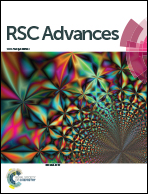High-yield fabrication of suspended two-dimensional materials for atomic resolution imaging†
Abstract
Two-dimensional (2D) atomic crystals are very interesting materials due to their unique properties, which are significantly different than those observed in conventional three-dimensional (3D) materials. The atomic crystal structure of 2D materials is very important in determining the properties of these materials. In this comparative study, the 2D atomic structures of graphene and h-BN, synthesized using low pressure chemical vapor deposition (LPCVD), were analyzed using a spherical aberration-corrected high resolution transmission electron microscope (HRTEM) for the in situ observation of the atomic scale phenomena. In order to prepare the suspended membrane of 2D materials on a TEM grid with high yield, a two-step approach for soft removal of PMMA is employed for atomic resolution imaging. Using our new method of preparing TEM samples, we obtained fully covered and well suspended graphene and h-BN membranes on TEM mesh grids with clean surfaces and few defects. Honeycomb lattice structures of monolayer graphene and h-BN were clearly observed, and their atomic defects were analyzed as growing into circular and triangular holes, respectively, upon irradiation using an electron beam.


 Please wait while we load your content...
Please wait while we load your content...